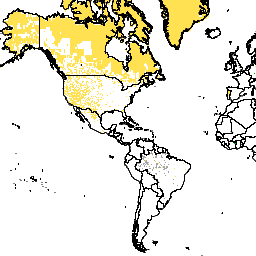
- Доступность набора данных
- 2000-01-01T00:00:00Z–2020-01-01T00:00:00Z
- Поставщик наборов данных
- NASA SEDAC в Центре международной информационной сети наук о Земле
- Теги
Описание
Этот набор данных идентифицирует пиксели, соответствующие воде; пиксели, не соответствующие воде, маскируются. Маска воды использовалась для исключения областей, покрытых водой и постоянным льдом, из распределения популяции.
Модель населения мира с координатной сеткой версии 4 (GPWv4), редакция 11, моделирует распределение населения мира за 2000, 2005, 2010, 2015 и 2020 годы в ячейках сетки с шагом 30 угловых секунд (приблизительно 1 км). Население распределяется по ячейкам пропорционально, исходя из данных переписи и административных единиц. Входные данные о населении собираются с максимально возможным пространственным разрешением, доступным по результатам раунда переписей 2010 года, проводившихся с 2005 по 2014 год. Входные данные экстраполируются для получения оценок численности населения для каждого моделируемого года.
Группы
Размер пикселя
927,67 метра
Группы
| Имя | Мин. | Макс | Размер пикселя | Описание | |||||||||||||||||||||||||||||||||||||||||||||||||||||||||||||||||||||||||||||||||||||||||||||||
|---|---|---|---|---|---|---|---|---|---|---|---|---|---|---|---|---|---|---|---|---|---|---|---|---|---|---|---|---|---|---|---|---|---|---|---|---|---|---|---|---|---|---|---|---|---|---|---|---|---|---|---|---|---|---|---|---|---|---|---|---|---|---|---|---|---|---|---|---|---|---|---|---|---|---|---|---|---|---|---|---|---|---|---|---|---|---|---|---|---|---|---|---|---|---|---|---|---|---|---|
water_mask | метров | Водная маска | |||||||||||||||||||||||||||||||||||||||||||||||||||||||||||||||||||||||||||||||||||||||||||||||||
Условия эксплуатации
Условия эксплуатации
Цитаты
Центр международной информационной сети по наукам о Земле (CIESIN) — Колумбийский университет. 2018. Gridded Population of the World, версия 4 (GPWv4): Water Mask, редакция 11. Палисейдс, штат Нью-Йорк: Центр социально-экономических данных и приложений НАСА (SEDAC). https://doi.org/10.7927/H42Z13KG . Дата обращения: ДЕНЬ МЕСЯЦ ГОД.
DOI
Исследуйте с Earth Engine
Редактор кода (JavaScript)
var dataset = ee.ImageCollection('CIESIN/GPWv411/GPW_Water_Mask'); var raster = dataset.select('water_mask'); var raster_vis = { 'min': 0.0, 'palette': [ '005ce6', '00ffc5', 'bed2ff', 'aed0f1' ], 'max': 3.0 }; Map.setCenter(-88.6, 26.4, 1); Map.addLayer(raster, raster_vis, 'water_mask');
